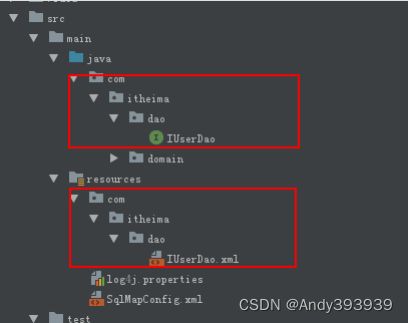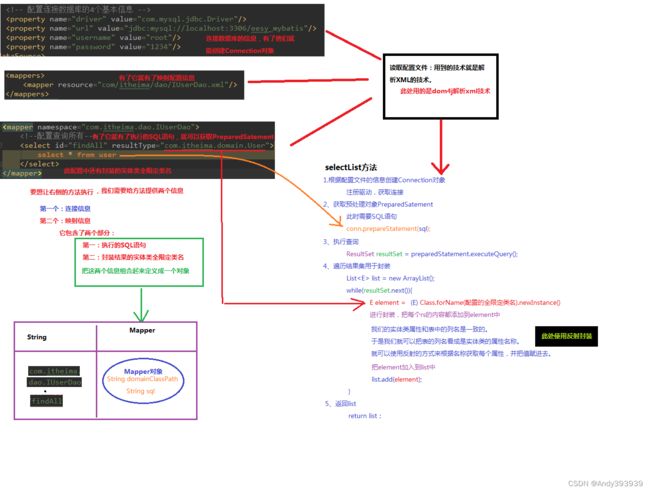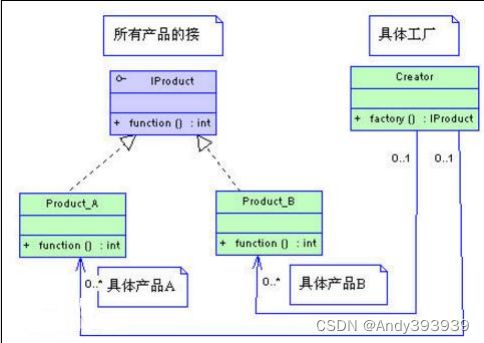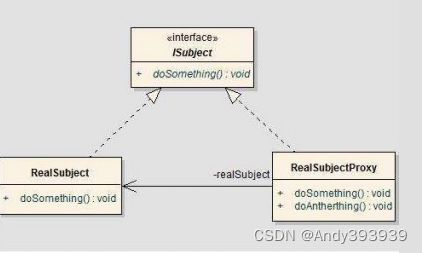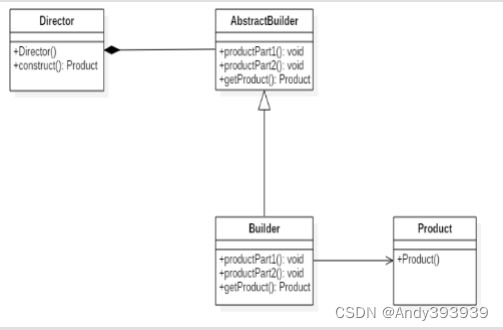java学习day45(Mybatis)Mybatis入门
课程安排:
mybatis框架共四天
第一天:mybatis入门
mybatis的概述
mybatis的环境搭建
mybatis入门案例
自定义mybatis框架(主要的目的是为了让大家了解mybatis中执行细节)
第二天:mybatis基本使用
mybatis的单表crud操作
mybatis的参数和返回值
mybatis的dao编写
mybatis配置的细节
几个标签的使用
第三天:mybatis的深入和多表
mybatis的连接池
mybatis的事务控制及设计的方法
mybatis的多表查询
一对多(多对一)
多对多
第四天:mybatis的缓存和注解开发
mybatis中的加载时机(查询的时机)
mybatis中的一级缓存和二级缓存
mybatis的注解开发
单表CRUD
多表查询
通过分层更好的实现了各个部分的职责,在每一层将再细化出不同的框架,分别解决各层关注的问题。
1.1.4 分层开发下的常见框架
3、解决技术整合问题的框架
1.1.5 MyBatis 框架概述
public static void main(String[] args) {
Connection connection = null;
PreparedStatement preparedStatement = null;
ResultSet resultSet = null;
try {
//加载数据库驱动
Class.forName("com.mysql.jdbc.Driver");
//通过驱动管理类获取数据库链接
connection = DriverManager
.getConnection("jdbc:mysql://localhost:3306/mybatis?characterEncoding=utf-8","ro
ot", "root");
//定义 sql 语句 ?表示占位符
String sql = "select * from user where username = ?";
//获取预处理 statement
preparedStatement = connection.prepareStatement(sql);
//设置参数,第一个参数为 sql 语句中参数的序号(从 1 开始),第二个参数为设置的
参数值
preparedStatement.setString(1, "王五");
//向数据库发出 sql 执行查询,查询出结果集
resultSet = preparedStatement.executeQuery();
//遍历查询结果集
while(resultSet.next()){
System.out.println(resultSet.getString("id")+"
"+resultSet.getString("username"));
}
} catch (Exception e) {
e.printStackTrace();
}finally{
//释放资源
if(resultSet!=null){
try {
resultSet.close();
} catch (SQLException e) {
e.printStackTrace();
}
}
if(preparedStatement!=null){
try {
preparedStatement.close();
} catch (SQLException e) {
e.printStackTrace();
}
}
if(connection!=null){
try {
connection.close();
} catch (SQLException e) {
// TODO Auto-generated catch block
e.printStackTrace();
}
}
}
}可参考:MyBatis下载和使用_最终变量的博客-CSDN博客_mybatis下载
org.mybatis
mybatis
3.4.5
junit
junit
4.10
test
mysql
mysql-connector-java
5.1.6
runtime
log4j
log4j
1.2.12
/**
*
* Title: User
* Description: 用户的实体类
* Company: http://www.itheima.com/
*/
public class User implements Serializable {
private Integer id;
private String username;
private Date birthday;
private String sex;
private String address;
public Integer getId() {
return id;
}
public void setId(Integer id) {
this.id = id;
}
public String getUsername() {
return username;
}
public void setUsername(String username) {
this.username = username;
}
public Date getBirthday() {
return birthday;
}
public void setBirthday(Date birthday) {
this.birthday = birthday;
}
public String getSex() {
return sex;
}
public void setSex(String sex) {
this.sex = sex;
}
public String getAddress() {
return address;
}
public void setAddress(String address) {
this.address = address;
}
@Override
public String toString() {
return "User [id=" + id + ", username=" + username + ", birthday=" + birthday
+ ", sex=" + sex + ", address="
+ address + "]";
}
}IUserDao 接口就是我们的持久层接口(也可以写成 UserDao 或者 UserMapper),具体代码如下:
/**
*
* Title: IUserDao
* Description: 用户的持久层操作
* Company: http://www.itheima.com/
*/
public interface IUserDao {
/**
* 查询所有用户
* @return
*/
List findAll();
}
2.2.6 编写 SqlMapConfig.xml 配置文件
/**
*
* Title: MybatisTest
* Description: 测试 mybatis 的环境
* Company: http://www.itheima.com/
*/
public class MybatisTest {
public static void main(String[] args)throws Exception {
//1.读取配置文件
InputStream in = Resources.getResourceAsStream("SqlMapConfig.xml");
//2.创建 SqlSessionFactory 的构建者对象
SqlSessionFactoryBuilder builder = new SqlSessionFactoryBuilder();
//3.使用构建者创建工厂对象 SqlSessionFactory
SqlSessionFactory factory = builder.build(in);
//4.使用 SqlSessionFactory 生产 SqlSession 对象
SqlSession session = factory.openSession();
//5.使用 SqlSession 创建 dao 接口的代理对象
IUserDao userDao = session.getMapper(IUserDao.class);
//6.使用代理对象执行查询所有方法
List users = userDao.findAll();
for(User user : users) {
System.out.println(user);
}
//7.释放资源
session.close();
in.close();
}
} /**
*
* Title: IUserDao
* Description: 用户的持久层操作
* Company: http://www.itheima.com/
*/
public interface IUserDao {
/**
* 查询所有用户
* @return
*/
@Select("select * from user")
List findAll();
}
创建 mybatis02 的工程,工程信息如下:Groupid :com.itheimaArtifactId :mybatis02Packing :jar
log4j
log4j
1.2.12
dom4j
dom4j
1.6.1
mysql
mysql-connector-java
5.1.6
jaxen
jaxen
1.1.6
junit
junit
4.10
/**
* 用于解析配置文件
*/
public class XMLConfigBuilder {
/**
* 解析主配置文件,把里面的内容填充到 DefaultSqlSession 所需要的地方
* 使用的技术:
* dom4j+xpath
* @param session
*/
public static void loadConfiguration(DefaultSqlSession session,InputStream
config){
try{
//定义封装连接信息的配置对象(mybatis 的配置对象)
Configuration cfg = new Configuration();
//1.获取 SAXReader 对象
SAXReader reader = new SAXReader();
//2.根据字节输入流获取 Document 对象
Document document = reader.read(config);
//3.获取根节点
Element root = document.getRootElement();
//4.使用 xpath 中选择指定节点的方式,获取所有 property 节点
List propertyElements = root.selectNodes("//property");
//5.遍历节点
for(Element propertyElement : propertyElements){
//判断节点是连接数据库的哪部分信息
//取出 name 属性的值
String name = propertyElement.attributeValue("name");
if("driver".equals(name)){
//表示驱动
//获取 property 标签 value 属性的值
String driver = propertyElement.attributeValue("value");
cfg.setDriver(driver);
}
if("url".equals(name)){
//表示连接字符串
//获取 property 标签 value 属性的值
String url = propertyElement.attributeValue("value");
cfg.setUrl(url);
}
if("username".equals(name)){
//表示用户名
//获取 property 标签 value 属性的值
String username = propertyElement.attributeValue("value");
cfg.setUsername(username);
}
if("password".equals(name)){
//表示密码
//获取 property 标签 value 属性的值
String password = propertyElement.attributeValue("value");
cfg.setPassword(password);
}
}
//取出 mappers 中的所有 mapper 标签,判断他们使用了 resource 还是 class 属性
List mapperElements = root.selectNodes("//mappers/mapper");
//遍历集合
for(Element mapperElement : mapperElements){
//判断 mapperElement 使用的是哪个属性
Attribute attribute = mapperElement.attribute("resource");
if(attribute != null){
System.out.println("使用的是 XML");
//表示有 resource 属性,用的是 XML
//取出属性的值
String mapperPath = attribute.getValue();// 获 取 属 性 的 值
"com/itheima/dao/IUserDao.xml"
//把映射配置文件的内容获取出来,封装成一个 map
Map mappers = loadMapperConfiguration(mapperPath);
//给 configuration 中的 mappers 赋值
cfg.setMappers(mappers);
}else{
System.out.println("使用的是注解");
//表示没有 resource 属性,用的是注解
//获取 class 属性的值
String daoClassPath = mapperElement.attributeValue("class");
//根据 daoClassPath 获取封装的必要信息
Map mappers = loadMapperAnnotation(daoClassPath);
//给 configuration 中的 mappers 赋值
cfg.setMappers(mappers);
}
}
//把配置对象传递给 DefaultSqlSession
session.setCfg(cfg);
}catch(Exception e){
throw new RuntimeException(e);
}finally{
try {
config.close();
}catch(Exception e){
e.printStackTrace();
}
}
}
/**
* 根据传入的参数,解析 XML,并且封装到 Map 中
* @param mapperPath 映射配置文件的位置
* @return map 中包含了获取的唯一标识(key 是由 dao 的全限定类名和方法名组成)
* 以及执行所需的必要信息(value 是一个 Mapper 对象,里面存放的是执行的 SQL 语句和
要封装的实体类全限定类名)
*/
private static Map loadMapperConfiguration(String
mapperPath)throws IOException {
InputStream in = null;
try{
//定义返回值对象
Map mappers = new HashMap();
//1.根据路径获取字节输入流
in = Resources.getResourceAsStream(mapperPath);
//2.根据字节输入流获取 Document 对象
SAXReader reader = new SAXReader();
Document document = reader.read(in);
//3.获取根节点
Element root = document.getRootElement();
//4.获取根节点的 namespace 属性取值
String namespace = root.attributeValue("namespace");//是组成 map 中 key 的
部分
//5.获取所有的 select 节点
List selectElements = root.selectNodes("//select");
//6.遍历 select 节点集合
for(Element selectElement : selectElements){
//取出 id 属性的值 组成 map 中 key 的部分
String id = selectElement.attributeValue("id");
//取出 resultType 属性的值 组成 map 中 value 的部分
String resultType = selectElement.attributeValue("resultType");
//取出文本内容 组成 map 中 value 的部分
String queryString = selectElement.getText();
//创建 Key
String key = namespace+"."+id;
//创建 Value
Mapper mapper = new Mapper();
mapper.setQueryString(queryString);
mapper.setResultType(resultType);
//把 key 和 value 存入 mappers 中
mappers.put(key,mapper);
}
return mappers;
}catch(Exception e){
throw new RuntimeException(e);
}finally{
in.close();
}
}
/**
* 根据传入的参数,得到 dao 中所有被 select 注解标注的方法。
* 根据方法名称和类名,以及方法上注解 value 属性的值,组成 Mapper 的必要信息
* @param daoClassPath
* @return
*/
private static Map loadMapperAnnotation(String
daoClassPath)throws Exception{
//定义返回值对象
Map mappers = new HashMap();
//1.得到 dao 接口的字节码对象
Class daoClass = Class.forName(daoClassPath);
//2.得到 dao 接口中的方法数组
Method[] methods = daoClass.getMethods();
//3.遍历 Method 数组
for(Method method : methods){
//取出每一个方法,判断是否有 select 注解
boolean isAnnotated = method.isAnnotationPresent(Select.class);
if(isAnnotated){
//创建 Mapper 对象
Mapper mapper = new Mapper();
//取出注解的 value 属性值
Select selectAnno = method.getAnnotation(Select.class);
String queryString = selectAnno.value();
mapper.setQueryString(queryString);
//获取当前方法的返回值,还要求必须带有泛型信息
Type type = method.getGenericReturnType();//List
//判断 type 是不是参数化的类型
if(type instanceof ParameterizedType){
//强转
ParameterizedType ptype = (ParameterizedType)type;
//得到参数化类型中的实际类型参数
Type[] types = ptype.getActualTypeArguments();
//取出第一个
Class domainClass = (Class)types[0];
//获取 domainClass 的类名
String resultType = domainClass.getName();
//给 Mapper 赋值
mapper.setResultType(resultType);
}
//组装 key 的信息
//获取方法的名称
String methodName = method.getName();
String className = method.getDeclaringClass().getName();
String key = className+"."+methodName;
//给 map 赋值
mappers.put(key,mapper);
}
}
return mappers;
}
}
/**
* 负责执行 SQL 语句,并且封装结果集
*/
public class Executor {
public List selectList(Mapper mapper, Connection conn) {
PreparedStatement pstm = null;
ResultSet rs = null;
try {
//1.取出 mapper 中的数据
String queryString = mapper.getQueryString();//select * from user
String resultType = mapper.getResultType();//com.itheima.domain.User
Class domainClass = Class.forName(resultType);//User.class
//2.获取 PreparedStatement 对象
pstm = conn.prepareStatement(queryString);
//3.执行 SQL 语句,获取结果集
rs = pstm.executeQuery();
//4.封装结果集
List list = new ArrayList();//定义返回值
while(rs.next()) {
//实例化要封装的实体类对象
E obj = (E)domainClass.newInstance();//User 对象
//取出结果集的元信息:ResultSetMetaData
ResultSetMetaData rsmd = rs.getMetaData();
//取出总列数
int columnCount = rsmd.getColumnCount();
//遍历总列数
for (int i = 1; i <= columnCount; i++) {
//获取每列的名称,列名的序号是从 1 开始的
String columnName = rsmd.getColumnName(i);
//根据得到列名,获取每列的值
Object columnValue = rs.getObject(columnName);
//给 obj 赋值:使用 Java 内省机制(借助 PropertyDescriptor 实现属性的封装)
PropertyDescriptor pd = new
PropertyDescriptor(columnName,domainClass);//要求:实体类的属性和数据库表的列名保持一种
//获取它的写入方法
Method writeMethod = pd.getWriteMethod();//setUsername(String
username);
//把获取的列的值,给对象赋值
writeMethod.invoke(obj,columnValue);
}
//把赋好值的对象加入到集合中
list.add(obj);
}
return list;
} catch (Exception e) {
throw new RuntimeException(e);
} finally {
release(pstm,rs);
}
}
private void release(PreparedStatement pstm,ResultSet rs){
if(rs != null){
try {
rs.close();
}catch(Exception e){
e.printStackTrace();
}
}
if(pstm != null){
try {
pstm.close();
}catch(Exception e){
e.printStackTrace();
}
}
}
}
/**
*
* Title: DataSourceUtil
* Description: 数据源的工具类
*/
public class DataSourceUtil {
/**
* 获取连接
* @param cfg
* @return
*/
public static Connection getConnection(Configuration cfg) {
try {
Class.forName(cfg.getDriver());
Connection conn =
DriverManager.getConnection(cfg.getUrl(),cfg.getUsername() , cfg.getPassword());
return conn;
} catch (Exception e) {
throw new RuntimeException(e);
}
}
}
/**
*
* Title: Resources
* Description: 用于读取配置文件的类
*/
public class Resources {
/**
* 用于加载 xml 文件,并且得到一个流对象
* @param xmlPath
* @return
* 在实际开发中读取配置文件:
* 第一:使用类加载器。但是有要求:a 文件不能过大。 b 文件必须在类路径下(classpath)
* 第二:使用 ServletContext 的 getRealPath()
*/
public static InputStream getResourceAsStream(String xmlPath) {
return Resources.class.getClassLoader().getResourceAsStream(xmlPath);
}
}/**
*
* Title: Mapper
* Description: 用于封装查询时的必要信息:要执行的 SQL 语句和实体类的全限定类名
*/
public class Mapper {
private String queryString;//sql
private String resultType;//结果类型的全限定类名
public String getQueryString() {
return queryString;
}
public void setQueryString(String queryString) {
this.queryString = queryString;
}
public String getResultType() {
return resultType;
}
public void setResultType(String resultType) {
this.resultType = resultType;
}
}
/**
* 核心配置类
* 1.数据库信息
* 2.sql 的 map 集合
*/
public class Configuration {
private String username; //用户名
private String password;//密码
private String url;//地址
private String driver;//驱动
//map 集合 Map<唯一标识,Mapper> 用于保存映射文件中的 sql 标识及 sql 语句
private Map mappers;
public String getUsername() {
return username;
}
public void setUsername(String username) {
this.username = username;
}
public String getPassword() {
return password;
}
public void setPassword(String password) {
this.password = password;
}
public String getUrl() {
return url;
}
public void setUrl(String url) {
this.url = url;
}
public String getDriver() {
return driver;
}
public void setDriver(String driver) {
this.driver = driver;
}
public Map getMappers() {
return mappers;
}
public void setMappers(Map mappers) {
this.mappers = mappers;
}
} public class User implements Serializable {
private int id;
private String username;// 用户姓名
private String sex;// 性别
private Date birthday;// 生日
private String address;// 地址
//省略 getter 与 setter
@Override
public String toString() {
return "User [id=" + id + ", username=" + username + ", sex=" + sex
+ ", birthday=" + birthday + ", address=" + address + "]";
}
}/**
*
* Title: IUserDao
* Description: 用户的持久层操作
*/
public interface IUserDao {
/**
* 查询所有用户
* @return
*/
List findAll();
}
注意:
此处我们使用的也是 mybatis 的配置文件,所以也要把约束删除了
/**
*
* Title: SqlSessionFactoryBuilder
* Description: 用于构建 SqlSessionFactory 的
*/
public class SqlSessionFactoryBuilder {
/**
* 根据传入的流,实现对 SqlSessionFactory 的创建
* @param in 它就是 SqlMapConfig.xml 的配置以及里面包含的 IUserDao.xml 的配置
* @return
*/
public SqlSessionFactory build(InputStream in) {
DefaultSqlSessionFactory factory = new DefaultSqlSessionFactory();
//给 factory 中 config 赋值
factory.setConfig(in);
return factory;
}
}/**
*
* Title: SqlSessionFactory
* Description: SqlSessionFactory 的接口
* Company: http://www.itheima.com/
*/
public interface SqlSessionFactory {
/**
* 创建一个新的 SqlSession 对象
* @return
*/
SqlSession openSession();
}
/**
*
* Title: DefaultSqlSessionFactory
* Description:SqlSessionFactory 的默认实现
* Company: http://www.itheima.com/
*/
public class DefaultSqlSessionFactory implements SqlSessionFactory {
private InputStream config = null;
public void setConfig(InputStream config) {
this.config = config;
}
@Override
public SqlSession openSession() {
DefaultSqlSession session = new DefaultSqlSession();
//调用工具类解析 xml 文件
XMLConfigBuilder.loadConfiguration(session, config);
return session;
}
}/**
*
* Title: SqlSession
* Description: 操作数据库的核心对象
*/
public interface SqlSession {
/**
* 创建 Dao 接口的代理对象
* @param daoClass
* @return
*/
T getMapper(Class daoClass);
/**
* 释放资源
*/
void close();
}
/**
*
* Title: DefaultSqlSession
* Description: SqlSession 的具体实现
*/
public class DefaultSqlSession implements SqlSession {
//核心配置对象
private Configuration cfg;
public void setCfg(Configuration cfg) {
this.cfg = cfg;
}
//连接对象
private Connection conn;
//调用 DataSourceUtils 工具类获取连接
public Connection getConn() {
try {
conn = DataSourceUtil.getDataSource(cfg).getConnection();
return conn;
} catch (Exception e) {
throw new RuntimeException(e);
}
}
/**
* 动态代理:
* 涉及的类:Proxy
* 使用的方法:newProxyInstance
* 方法的参数:
* ClassLoader:和被代理对象使用相同的类加载器,通常都是固定的
* Class[]:代理对象和被代理对象要求有相同的行为。(具有相同的方法)
* InvocationHandler:如何代理。需要我们自己提供的增强部分的代码
*/
@Override
public T getMapper(Class daoClass) {
conn = getConn();
System.out.println(conn);
T daoProxy = (T) Proxy.newProxyInstance(daoClass.getClassLoader(),new
Class[] {daoClass}, new MapperProxyFactory(cfg.getMappers(),conn));
return daoProxy;
}
//释放资源
@Override
public void close() {
try {
System.out.println(conn);
conn.close();
} catch (SQLException e) {
e.printStackTrace();
}
}
//查询所有方法
public List selectList(String statement){
Mapper mapper = cfg.getMappers().get(statement);
return new Executor().selectList(mapper,conn);
}
} /**
*
* Title: MapperProxyFactory
* Description: 用于创建代理对象是增强方法
*/
public class MapperProxyFactory implements InvocationHandler {
private Map mappers;
private Connection conn;
public MapperProxyFactory(Map mappers,Connection conn) {
this.mappers = mappers;
this.conn = conn;
}
/**
* 对当前正在执行的方法进行增强
* 取出当前执行的方法名称
* 取出当前执行的方法所在类
* 拼接成 key
* 去 Map 中获取 Value(Mapper)
* 使用工具类 Executor 的 selectList 方法
*/
@Override
public Object invoke(Object proxy, Method method, Object[] args) throws Throwable
{
//1.取出方法名
String methodName = method.getName();
//2.取出方法所在类名
String className = method.getDeclaringClass().getName();
//3.拼接成 Key
String key = className+"."+methodName;
//4.使用 key 取出 mapper
Mapper mapper = mappers.get(key);
if(mapper == null) {
throw new IllegalArgumentException("传入的参数有误,无法获取执行的必要条件
");
}
//5.创建 Executor 对象
Executor executor = new Executor();
return executor.selectList(mapper, conn);
}
} /**
*
* Title: MybatisTest
* Description: 测试 mybatis 的环境
*/
public class MybatisTest {
public static void main(String[] args)throws Exception {
//1.读取配置文件
InputStream in = Resources.getResourceAsStream("SqlMapConfig.xml");
//2.创建 SqlSessionFactory 的构建者对象
SqlSessionFactoryBuilder builder = new SqlSessionFactoryBuilder();
//3.使用构建者创建工厂对象 SqlSessionFactory
SqlSessionFactory factory = builder.build(in);
//4.使用 SqlSessionFactory 生产 SqlSession 对象
SqlSession session = factory.openSession();
//5.使用 SqlSession 创建 dao 接口的代理对象
IUserDao userDao = session.getMapper(IUserDao.class);
//6.使用代理对象执行查询所有方法
List users = userDao.findAll();
for(User user : users) {
System.out.println(user);
}
//7.释放资源
session.close();
in.close();
}
} /**
*
* Title: Select
* Description: 自定义查询注解
*/
@Retention(RetentionPolicy.RUNTIME)
@Target(ElementType.METHOD)
public @interface Select {
String value();
}/**
*
* Title: IUserDao
* Description: 用户的持久层操作
*/
public interface IUserDao {
/**
* 查询所有用户
* @return
*/
@Select("select * from user")
List findAll();
}
工厂模式的原理如下图:
3.5.2 代理模式(MapperProxyFactory)
具体设计模式的模型图如下:
1、什么是框架?
它是我们软件开发中的一套解决方案,不同的框架解决的是不同的问题。
使用框架的好处:
框架封装了很多的细节,使开发者可以使用极简的方式实现功能。大大提高开发效率。
2、三层架构
表现层:
是用于展示数据的
业务层:
是处理业务需求
持久层:
是和数据库交互的
3、持久层技术解决方案
JDBC技术:
Connection
PreparedStatement
ResultSet
Spring的JdbcTemplate:
Spring中对jdbc的简单封装
Apache的DBUtils:
它和Spring的JdbcTemplate很像,也是对Jdbc的简单封装
以上这些都不是框架
JDBC是规范
Spring的JdbcTemplate和Apache的DBUtils都只是工具类
4、mybatis的概述
mybatis是一个持久层框架,用java编写的。
它封装了jdbc操作的很多细节,使开发者只需要关注sql语句本身,而无需关注注册驱动,创建连接等繁杂过程
它使用了ORM思想实现了结果集的封装。
ORM:
Object Relational Mappging 对象关系映射
简单的说:
就是把数据库表和实体类及实体类的属性对应起来
让我们可以操作实体类就实现操作数据库表。
user User
id userId
user_name userName
今天我们需要做到
实体类中的属性和数据库表的字段名称保持一致。
user User
id id
user_name user_name
5、mybatis的入门
mybatis的环境搭建
第一步:创建maven工程并导入坐标
第二步:创建实体类和dao的接口
第三步:创建Mybatis的主配置文件
SqlMapConifg.xml
第四步:创建映射配置文件
IUserDao.xml
环境搭建的注意事项:
第一个:创建IUserDao.xml 和 IUserDao.java时名称是为了和我们之前的知识保持一致。
在Mybatis中它把持久层的操作接口名称和映射文件也叫做:Mapper
所以:IUserDao 和 IUserMapper是一样的
第二个:在idea中创建目录的时候,它和包是不一样的
包在创建时:com.itheima.dao它是三级结构
目录在创建时:com.itheima.dao是一级目录
第三个:mybatis的映射配置文件位置必须和dao接口的包结构相同
第四个:映射配置文件的mapper标签namespace属性的取值必须是dao接口的全限定类名
第五个:映射配置文件的操作配置(select),id属性的取值必须是dao接口的方法名
当我们遵从了第三,四,五点之后,我们在开发中就无须再写dao的实现类。
mybatis的入门案例
第一步:读取配置文件
第二步:创建SqlSessionFactory工厂
第三步:创建SqlSession
第四步:创建Dao接口的代理对象
第五步:执行dao中的方法
第六步:释放资源
注意事项:
不要忘记在映射配置中告知mybatis要封装到哪个实体类中
配置的方式:指定实体类的全限定类名
mybatis基于注解的入门案例:
把IUserDao.xml移除,在dao接口的方法上使用@Select注解,并且指定SQL语句
同时需要在SqlMapConfig.xml中的mapper配置时,使用class属性指定dao接口的全限定类名。
明确:
我们在实际开发中,都是越简便越好,所以都是采用不写dao实现类的方式。
不管使用XML还是注解配置。
但是Mybatis它是支持写dao实现类的。
6、自定义Mybatis的分析:
mybatis在使用代理dao的方式实现增删改查时做什么事呢?
只有两件事:
第一:创建代理对象
第二:在代理对象中调用selectList
自定义mybatis能通过入门案例看到类
class Resources
class SqlSessionFactoryBuilder
interface SqlSessionFactory
interface SqlSession





